

Dieter Roth. Modern Masters: Andy Warhol - Documentary - Artist. Mariko Mori. Mariko Mori (森 万里子, Mori Mariko, born 1967 in Tokyo, Japan) is a contemporary Japanese video and photographic artist.
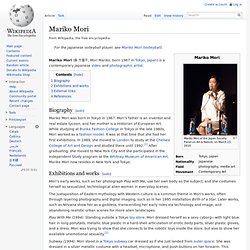
Biography[edit] Mariko Mori was born in Tokyo in 1967. Mori's father is an inventor and real estate tycoon, and her mother is a Historian of European Art. While studying at Bunka Fashion College in Tokyo in the late 1980s, Mori worked as a fashion model. It was at that time that she had her first exhibitions. Homer. In the Western classical tradition, Homer (/ˈhoʊmər/; Ancient Greek: Ὅμηρος [hómɛːros], Hómēros) is the author of the Iliad and the Odyssey, and is revered as the greatest of ancient Greek epic poets.

These epics lie at the beginning of the Western canon of literature, and have had an enormous influence on the history of literature. When he lived is unknown. Herodotus estimates that Homer lived 400 years before his own time, which would place him at around 850 BC,[1] while other ancient sources claim that he lived much nearer to the supposed time of the Trojan War, in the early 12th century BC.[2] Most modern researchers place Homer in the 7th or 8th centuries BC. Art and Craft Movement. THE ARTS AND CRAFTS MOVEMENT (ACM) aimed to promote a return to hand-craftsmanship and to assert the creative independence of individual craftspeople. It was a reaction against the industrialised society that had boomed in Britain in the Victorian period, and aimed for social as well as artistic reform.
Its example was followed in other countries, particularly the U.S.A. After the 1914-18 war, other artistic trends overtook the ACM, and it declined. Voltri XV. Voltri XV It is part of the Voltri series created in May through June 1962 in Italy.[1] He worked at an abandoned steel factory, where he welded scrap steel. With assistants, he produced Twenty Six sculptures in thirty days.[2] It showed at Spoleto, Italy,[3] the White House,[4] and the Guggenheim Museum,[5] and is at the Hirshhorn Museum and Sculpture Garden.[6] References[edit] External links[edit] Where is frank auerbach's studio. Art Basel Miami Beach - in pictures. Jeff Koons. Jeffrey "Jeff" Koons (born January 21, 1955) is an American artist known for his reproductions of banal objects—such as balloon animals produced in stainless steel with mirror finish surfaces.
He lives and works in both New York City and his hometown of York, Pennsylvania. His works have sold for substantial sums of money, including at least one world record auction price for a work by a living artist. Critics are sharply divided in their views of Koons. International Exhibition of the New Realists. Destruction in Art Symposium. The Destruction in Art Symposium (DIAS) was a gathering of a diverse group of international artists, poets, and scientists to London, from 9–11 September 1966. Included in this number were representatives of the counter-cultural underground who were there to speak on the theme of destruction in art.
The Honorary Committee, led by Gustav Metzger, attracted the attention of both the international media and international art community to the symposium.[1] Event[edit] The symposium was held at the Africa Centre in Covent Garden, London. Objectives[edit] A DIAS press release claimed: Neo-pop. Neo-pop is a postmodern art[1] movement of the 1980s. The term refers to artists influenced by pop art, such as Jeff Koons[2] and Sam Havadtoy in the USA. In the 2000s the work of Takashi Murakami in Japan and in 2009 the Arts project Nicolas Lepaulmier in French has also been described as neo-pop. Ken Done in Australia became world famous for his businesslike approach to art related merchandise including tea towels, key rings, t-shirts, sarongs. See also[edit] Jeff Koons. Jeffrey "Jeff" Koons (born January 21, 1955) is an American artist known for his reproductions of banal objects—such as balloon animals produced in stainless steel with mirror finish surfaces.
He lives and works in both New York City and his hometown of York, Pennsylvania. His works have sold for substantial sums of money, including at least one world record auction price for a work by a living artist. Critics are sharply divided in their views of Koons. Kurt Kren. Kurt Kren (September 20, 1929 - died in Vienna on June 23, 1998) was an Austrian avant-garde filmmaker. He is best known for his involvement with the Vienna Aktionists and the group of films that resulted, although this accounts for only a part of his career, and he later returned to the Structural roots of his third film 3/60: Bäume Im Herbst. Although not a seminal Structural film, 31/75: Asyl is arguably one of the more satisfying films of the movement. Biography[edit] Viennese Actionism. Viennese Actionism was a short and violent movement in 20th-century art.
It can be regarded as part of the many independent efforts of the 1960s to develop "action art" (Fluxus, happening, performance art, body art, etc.). Its main participants were Günter Brus, Otto Mühl, Hermann Nitsch, and Rudolf Schwarzkogler. As "actionists", they were active between 1960 and 1971. Most have continued their artistic work independently from the early 1970s onwards. New British Sculpture. Tim Woods has characterized the movement by identifying four major themes, "(a) a synthesis of pop and kitsch, (b) a bricolage (assemblage) of the decaying UK urban environment and the waste of consumer society, (c) an exploration of the way in which objects are assigned meanings, and (d) a play of colour, wit and humour.
"[2] An early champion was art dealer Nicholas Logsdail who exhibited many of the artists at his Lisson Gallery. Artists[edit] Henri de Toulouse-Lautrec. Henri Marie Raymond de Toulouse-Lautrec-Monfa or simply Henri de Toulouse-Lautrec (French: [ɑ̃ʁi də tuluz lotʁɛk]; 24 November 1864 – 9 September 1901) was a French painter, printmaker, draughtsman and illustrator whose immersion in the colourful and theatrical life of Paris in the late 19th century yielded a collection of exciting, elegant and provocative images of the modern and sometimes decadent life of those times.
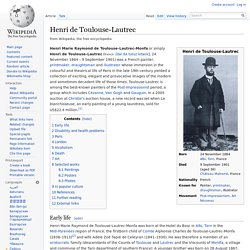
Toulouse-Lautrec is among the best-known painters of the Post-Impressionist period, a group which includes Cézanne, Van Gogh and Gauguin. In a 2005 auction at Christie's auction house, a new record was set when La blanchisseuse, an early painting of a young laundress, sold for US$22.4 million.[1] Early life[edit] New York School. The New York School (synonymous with abstract expressionist painting) was an informal group of American poets, painters, dancers, and musicians active in the 1950s, 1960s in New York City.
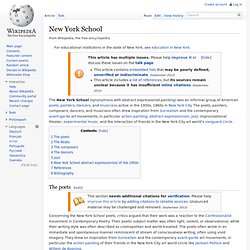
The poets, painters, composers, dancers, and musicians often drew inspiration from Surrealism and the contemporary avant-garde art movements, in particular action painting, abstract expressionism, Jazz, improvisational theater, experimental music, and the interaction of friends in the New York City art world's vanguard circle. The poets[edit] Concerning the New York School poets, critics argued that their work was a reaction to the Confessionalist movement in Contemporary Poetry. UbuWeb. Germany-DADA: An Alphabet of German DADAism.
ImagePlanet's channel. Smithsonian Resident Associates Program - From R. Mutt to Monty Python: The Meaning and Legacy of Dada. Expect the unexpected in this roller-coaster ride of a program full of “ah-ha!” Moments. Find your own meanings in the seemingly incomprehensible forms of expression known as Dada. What was going on when Marcel Duchamp submitted , a “readymade” sculpture, to a prestigious art show in 1917?
The instantly infamous inverted urinal signed by a comic strip character caused an uproar; two years later, Duchamp displayed a defaced poster of Mona Lisa with a goatee. The horrors of World War I drove many artists and writers to Zurich. Presenter is a professor of philosophy and humanities at East Tennessee State University. How Do You Say Dada? Situationists. The Rite of Spring. The Rite of Spring (French: Le Sacre du printemps, Russian: «Весна священная», Vesna svyashchennaya) is a ballet and orchestral concert work by the Russian composer Igor Stravinsky.

It was written for the 1913 Paris season of Sergei Diaghilev's Ballets Russes company; the original choreography was by Vaslav Nijinsky, with stage designs and costumes by Nicholas Roerich. Art manifesto. Paul Cézanne. Paul Cézanne (US /seɪˈzæn/ or UK /sɨˈzæn/; French: [pɔl sezan]; 1839–1906) was a French artist and Post-Impressionist painter whose work laid the foundations of the transition from the 19th-century conception of artistic endeavour to a new and radically different world of art in the 20th century.
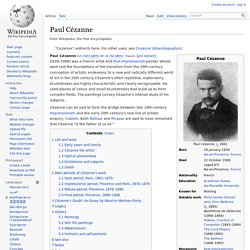
Cézanne's often repetitive, exploratory brushstrokes are highly characteristic and clearly recognizable. He used planes of colour and small brushstrokes that build up to form complex fields. The paintings convey Cézanne's intense study of his subjects. Cézanne can be said to form the bridge between late 19th-century Impressionism and the early 20th century's new line of artistic enquiry, Cubism. Both Matisse and Picasso are said to have remarked that Cézanne "is the father of us all. " Dada. 391 (magazine) 391 was a periodical created and edited by the Dadaist Francis Picabia.

Fluxus. Fluxus—a name taken from a Latin word meaning "flow, flux" (noun); "flowing, fluid" (adj.)[1]—is an international network of artists, composers and designers noted for blending different artistic media and disciplines in the 1960s.
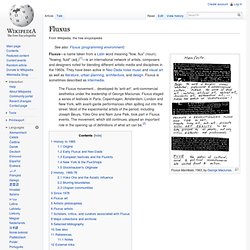
Nam June Paik. Joseph Beuys. Yoko Ono. The Beatles. The Beatles were an English rock band that formed in Liverpool, in 1960.
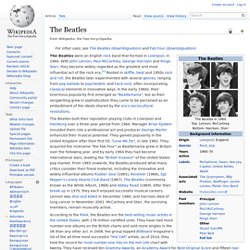
Monty Python. Monty Python (sometimes known as The Pythons)[2][3] are a British surreal comedy group that created Monty Python's Flying Circus, a British television comedy sketch show that first aired on the BBC on 5 October 1969. Forty-five episodes were made over four series. Cabaret Voltaire (Zurich) Pop art. Dada Manifesto (1916, Hugo Ball) The ABC's of DADA (2 of 3) Jean Arp. Kurt Schwitters. Nouveau réalisme. Arman. Jean Tinguely. Jacques Villeglé. Pierre Restany. Raymond Hains. Yves Klein. Daniel Spoerri. An Anecdoted Topography of Chance Atlas Arkhive: Documents of the Avant-Garde: Amazon.co.uk: Daniel Spoerri, Dieter Rot, Emmett Williams, Robert Filliou, etc., Roland Topor, Malcolm Green.
Marcel Janco. Tristan Tzara. Wassily Kandinsky. Americanwiki / Abstract Expressionism and Surrealism. Abstract expressionism. Franz Kline. Willem de Kooning. Color Field. Frank Stella. Franz West. Mark Rothko. Robert Motherwell. Clyfford Still. Jackson Pollock. Francis Bacon (artist) The Brutality of Fact: Interviews with Francis Bacon: Amazon.co.uk: David Sylvester. Elsa von Freytag-Loringhoven. Marcel Duchamp. André Masson. Joan Miró. Salvador Dalí. The Dali Dimension: Decoding the Mind of a Genius : DVD Talk Review of the DVD Video. Dali - Impressions de la Haute Mongolie part 1 English subtitles. André Breton. The Automatic Message. Diego Rivera. Un Cadavre. Nadja (novel) Les Champs Magnétiques. Paul Éluard. Erik Satie. Web Papers: Tristan Tzara - Dada Manifesto (23rd march 1918)
Web Papers: Francis Picabia - Dada Manifesto (March 1920 ) Cubism. Pablo Picasso. Futurist Manifesto. George Antheil. Luigi Russolo. Since the Sixties. Artist statements. Read an extract from : 100 Artists' Manifestos. Land art. City (artwork) Jacek Tylicki.